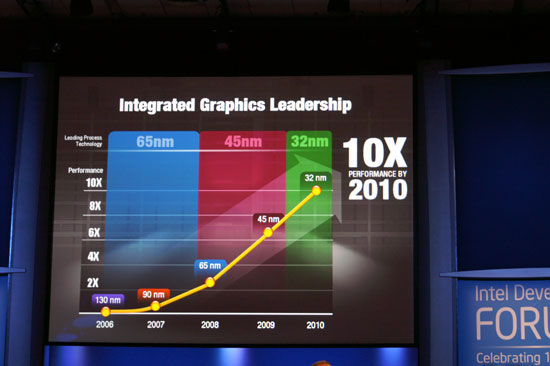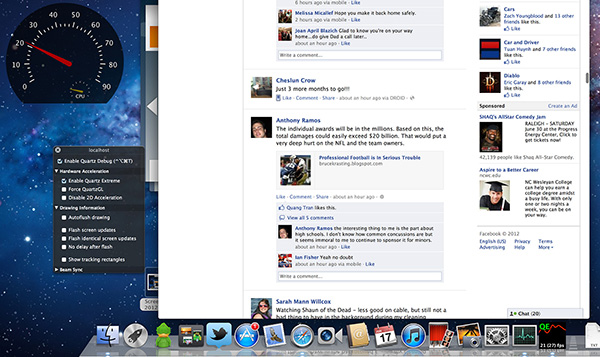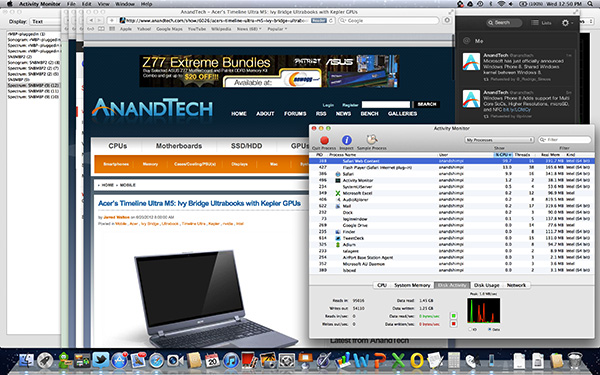The next-gen MacBook Pro with Retina Display Review
by Anand Lal Shimpi on June 23, 2012 4:14 AM EST- Posted in
- Mac
- Apple
- MacBook Pro
- Laptops
- Notebooks
Driving the Retina Display: A Performance Discussion
As I mentioned earlier, there are quality implications of choosing the higher-than-best resolution options in OS X. At 1680 x 1050 and 1920 x 1200 the screen is drawn with 4x the number of pixels, elements are scaled appropriately, and the result is downscaled to 2880 x 1800. The quality impact is negligible however, especially if you actually need the added real estate. As you’d expect, there is also a performance penalty.
At the default setting, either Intel’s HD 4000 or NVIDIA’s GeForce GT 650M already have to render and display far more pixels than either GPU was ever intended to. At the 1680 and 1920 settings however the GPUs are doing more work than even their high-end desktop counterparts are used to. In writing this article it finally dawned on me exactly what has been happening at Intel over the past few years.
Steve Jobs set a path to bringing high resolution displays to all of Apple’s products, likely beginning several years ago. There was a period of time when Apple kept hiring ex-ATI/AMD Graphics CTOs, first Bob Drebin and then Raja Koduri (although less public, Apple also hired chief CPU architects from AMD and ARM among other companies - but that’s another story for another time). You typically hire smart GPU guys if you’re building a GPU, the alternative is to hire them if you need to be able to work with existing GPU vendors to deliver the performance necessary to fulfill your dreams of GPU dominance.
In 2007 Intel promised to deliver a 10x improvement in integrated graphics performance by 2010:

In 2009 Apple hired Drebin and Koduri.
In 2010 Intel announced that the curve had shifted. Instead of 10x by 2010 the number was now 25x. Intel’s ramp was accelerated, and it stopped providing updates on just how aggressive it would be in the future. Paul Otellini’s keynote from IDF 2010 gave us all a hint of what’s to come (emphasis mine):
But there has been a fundamental shift since 2007. Great graphics performance is required, but it isn't sufficient anymore. If you look at what users are demanding, they are demanding an increasingly good experience, robust experience, across the spectrum of visual computing. Users care about everything they see on the screen, not just 3D graphics. And so delivering a great visual experience requires media performance of all types: in games, in video playback, in video transcoding, in media editing, in 3D graphics, and in display. And Intel is committed to delivering leadership platforms in visual computing, not just in PCs, but across the continuum.
Otellini’s keynote would set the tone for the next few years of Intel’s evolution as a company. Even after this keynote Intel made a lot of adjustments to its roadmap, heavily influenced by Apple. Mobile SoCs got more aggressive on the graphics front as did their desktop/notebook counterparts.
At each IDF I kept hearing about how Apple was the biggest motivator behind Intel’s move into the GPU space, but I never really understood the connection until now. The driving factor wasn’t just the demands of current applications, but rather a dramatic increase in display resolution across the lineup. It’s why Apple has been at the forefront of GPU adoption in its iDevices, and it’s why Apple has been pushing Intel so very hard on the integrated graphics revolution. If there’s any one OEM we can thank for having a significant impact on Intel’s roadmap, it’s Apple. And it’s just getting started.
Sandy Bridge and Ivy Bridge were both good steps for Intel, but Haswell and Broadwell are the designs that Apple truly wanted. As fond as Apple has been of using discrete GPUs in notebooks, it would rather get rid of them if at all possible. For many SKUs Apple has already done so. Haswell and Broadwell will allow Apple to bring integration to even some of the Pro-level notebooks.
To be quite honest, the hardware in the rMBP isn’t enough to deliver a consistently smooth experience across all applications. At 2880 x 1800 most interactions are smooth but things like zooming windows or scrolling on certain web pages is clearly sub-30fps. At the higher scaled resolutions, since the GPU has to render as much as 9.2MP, even UI performance can be sluggish. There’s simply nothing that can be done at this point - Apple is pushing the limits of the hardware we have available today, far beyond what any other OEM has done. Future iterations of the Retina Display MacBook Pro will have faster hardware with embedded DRAM that will help mitigate this problem. But there are other limitations: many elements of screen drawing are still done on the CPU, and as largely serial architectures their ability to scale performance with dramatically higher resolutions is limited.
Some elements of drawing in Safari for example aren’t handled by the GPU. Quickly scrolling up and down on the AnandTech home page will peg one of the four IVB cores in the rMBP at 100%:
The GPU has an easy time with its part of the process but the CPU’s workload is borderline too much for a single core to handle. Throw a more complex website at it and things get bad quickly. Facebook combines a lot of compressed images with text - every single image is decompressed on the CPU before being handed off to the GPU. Combine that with other elements that are processed on the CPU and you get a recipe for choppy scrolling.
To quantify exactly what I was seeing I measured frame rate while scrolling as quickly as possible through my Facebook news feed in Safari on the rMBP as well as my 2011 15-inch High Res MacBook Pro. While last year’s MBP delivered anywhere from 46 - 60 fps during this test, the rMBP hovered around 20 fps (18 - 24 fps was the typical range).

Scrolling in Safari on a 2011, High Res MBP - 51 fps

Scrolling in Safari on the rMBP - 21 fps
Remember at 2880 x 1800 there are simply more pixels to push and more work to be done by both the CPU and the GPU. It’s even worse in those applications that have higher quality assets: the CPU now has to decode images at 4x the resolution of what it’s used to. Future CPUs will take this added workload into account, but it’ll take time to get there.
The good news is Mountain Lion provides some relief. At WWDC Apple mentioned the next version of Safari is ridiculously fast, but it wasn’t specific about why. It turns out that Safari leverages Core Animation in Mountain Lion and more GPU accelerated as a result. Facebook is still a challenge because of the mixture of CPU decoded images and a standard web page, but the experience is a bit better. Repeating the same test as above I measured anywhere from 20 - 30 fps while scrolling through Facebook on ML’s Safari.
Whereas I would consider the rMBP experience under Lion to be borderline unacceptable, everything is significantly better under Mountain Lion. Don’t expect buttery smoothness across the board, you’re still asking a lot of the CPU and GPU, but it’s a lot better.











471 Comments
View All Comments
EnzoFX - Saturday, June 23, 2012 - link
Just let apple push down the high end tech, let it trickle, and let pc manufacturers bring up their game, is it not a win win? Haters gonna hate, so lost.MacTheSpoon - Saturday, June 23, 2012 - link
I have to say, after having tried one out in an Apple Store, that I was pretty surprised how underwhelming and minor the screen improvement was. I would have thought from all the breathless press coverage that it was going to be a life-changer like apparently it was for Anand, but the fact was that looking at the thing at waist-height on its bench I personally couldn't even tell the difference. I had to stick my nose in it to see a difference. From a normal typing distance I could see a bit more of a difference, but not as much as I'd imagined.Maybe it's just that I have crappy eyes, but I didn't see a single other customer in the store looking at the displayed laptops, either. I bet most walked by without even noticing the different display--because laptops are already pretty close to a retina display at normal usage distances. It's not like a phone, where you hold the thing up to your face.
I also found it disappointing that 1080p stuff looked so small. You had to blow it up to full screen, and then it seemed...well, it didn't seem that sharp. It was pretty underwhelming. My test material was the Big Buck Bunny vid on YouTube. I thought, so I would pay all this money and end up with this subpar viewing experience?
Honestly I think I would probably prefer a great 1080p display with a full sRGB gamut. I like the black levels and contrast on the MBP, but you can pretty much get that and more on other laptops. And matte, too.
The thing that I liked most about the machine, when all was said and done, was its looks. I love the thinness. And the lack of the wedge shape, which never appealed to me. But I left the store feeling like I wasn't missing out on anything too amazing by not having that screen. For a pro machine I'd probably want a workstation with full gamut and as much storage as possible. For a multimedia machine I'd probably wait to see how the XPS 15 redesign turned out. It will probably offer better speakers, storage, and color for less than half the price.
Ohhmaagawd - Saturday, June 23, 2012 - link
I had exact opposite reaction. I went to the Apple store yesterday and was blown away by the screen.But you can't use youtube for your testing, they are all fuzzy.
Spoony - Saturday, June 23, 2012 - link
Sublime review, as we always relish from Anandtech.To follow up, what do we know about the thermal performance of Kepler and IVB in the 2011-style MBP chassis?
Additionally, does opting for the 2.3GHz model do any significant favors for temperature or battery life?
Reading this review on a Retina iPad was amusing because all the pictures were fuzzy. The web has a way to go before it looks great at 220+ dpi.
da1bigkahuna - Saturday, June 23, 2012 - link
I was wondering if you had any fairly broad comparisons you could make that we might expect from Haswell - and it's successor. I mean something like, "Haswell should be at least 10% faster overall, but the next chip will increase speed far more". Any info would be appreciated, but ultimately speed is the main thing. Next main thing would be if thunderbolt will be a lot better in those future systems.dagamer34 - Saturday, June 23, 2012 - link
I believe Haswell is another tock in terms of GPU design, and all CPUs are designed for far lower thermal limits. Anand has referred to it as the "ideal" ultrabook CPU, allowing for it to even be in the screen of a computer with a minor increase in thickness.houkouonchi - Saturday, June 23, 2012 - link
The reason I bought my first Mac. Of course I run at the native 2880x1800 (I ditch the HiDPI).The big problem I have had so far is getting it working in linux. Seems like really bad linux support right now. The nvidia driver doesn't want to work and the thunderbolt ethernet also doesn't work. The wireless is also really shoddy which made it a pain in the but to just get my linux installation moved over (probably easier if I installed off a USB cd-rom drive).
I am coming from a 22.2 inch 3840x2400 (204PPI monitor) so going to a 220 PPI laptop at native resolution was no big stretch for me. On linux I run X at 75 DPI even on those dense monitors. Its all about the desktop real-estate for me.
houkouonchi - Saturday, June 23, 2012 - link
Just to add its funny that running at the native 2880x1800 is the only way to have third-party apps look good (like word processors/excel/pdf that you can up the font/text size on). Also using safari + google maps the plugin was rendered at 1/4th the resolution. Rendered correctly when running native 2880x1800.krazyfrog - Saturday, June 23, 2012 - link
I would like you guys to add a webcam test as it will help judge the quality of the built-in webcam and microphones. Otherwise, a fantastic review, as usual.LuckyKnight - Saturday, June 23, 2012 - link
I hope Apple release a 13" Macbook Pro with dedicated graphics and a slightly better screen!!